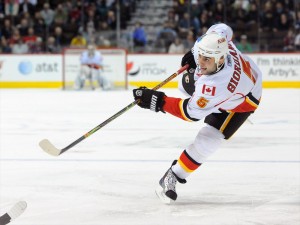As the 2014-15 National Hockey League season moves head-long towards the one-third mark of the schedule, two questions are emanating out of the province of Alberta.

“Why are the Calgary Flames doing so well?” “Why are the Edmonton Oilers doing so poorly?”
The answers stem from their rebuilds and the circumstances surrounding them.
While the Edmonton Oilers haven’t made the playoffs since going to the Stanley Cup Final in 2006, an argument can be made that their rebuild only began in earnest with the 2009-10 season, when they finished dead-last and drafted first overall for the first time. By that charitable estimate, this would be the sixth season of the Edmonton rebuild. To contrast, the Calgary Flames began their rebuild when they traded Jarome Iginla in March of 2013, so this is the second season of that process.
There are two major differences between the approach taken in the two cities.
TEAM MANAGEMENT
The Oilers are primarily helmed by two individuals – president of hockey operations Kevin Lowe and general manager Craig MacTavish. Lowe was promoted to his current position in 2008-09, after the Oilers had missed the playoffs for three straight seasons. MacTavish was coaching the team when the bottom fell out and he was axed the same season that Lowe was promoted. He was rehired as a consultant in 2012 and promoted to GM a season later.
Both men have long-standing ties to the Oilers organization, as well as have been around for the majority of the Oilers’ slide into mediocrity and despair.
In Calgary, things are considerably different. The head of hockey operations is long-time NHL executive Brian Burke, brought in by ownership to jump-start the rebuild. He immediately conducted a review of the organization and axed former GM Jay Feaster, bringing in rookie GM Brad Treliving from Phoenix to run the show. Neither man has ties to the Flames organization, neither was around for the Flames’ prior struggles and both bring some much-needed credibility and outside objectivity to the team’s rebuild.
ON-ICE LEADERSHIP

This point was mentioned to me by Sportsnet’s Mark Spector during training camp.
Calgary’s key players, the guys that eat up the hard minutes and are relied upon in tough situations, are generally the veterans: Matt Stajan, Curtis Glencross, Mark Giordano, Jiri Hudler, and perhaps some younger veterans like Mikael Backlund and T.J. Brodie. On the flip side, the rookies are allowed to be shielded and sheltered, and allowed to percolate in the lower lines or in the American Hockey League until they’re ready for more. Granted, part of this approach is because Calgary had very little NHL-ready prospect depth up until a couple seasons ago, so veterans were the backbone of the roster out of necessity.
In Edmonton, the players in key situations and the hard minutes have generally been quite young. Part of that is because Edmonton had extremely high draft picks – three first overall picks in a row, in fact – and had the talent to put into the NHL. However, the Oilers’ rosters have been thin of key veterans at the high end since around 2009-10, and since then the Oilers’ best players have been extremely young and the team has failed to get much traction in the standings. Only recently has Oilers management attempted to complement these youngsters with grizzled veterans.
CULTURE
A product of the first two points, really, culture is one main difference between the two cities.
In Calgary, it’s year two of the rebuild. Mark Giordano has emerged as an elite NHL player and many of the young players are progressing even faster than optimists could have hoped for – notably T.J. Brodie and Sean Monahan. They’ve become adept at staying in games and winning via late-game comebacks – they’re 5-7-0 when trailing after two periods, with their number of wins leading the entire NHL. Head coach Bob Hartley deserves praise for the progression of the club, and he’s kept the atmosphere light around the team. The team has so far out-paced the admittedly low expectations many had for the group, and even if the team goes on a bit of a skid this season, they’ve definitely opened eyes around the league.
In Edmonton, depending on your math, it’s either year six or eight of the rebuild. As of this writing, the Oilers have lost 11 games in a row. And they have lost games they were leading, and they have lost games in nearly every manner a team can lose a hockey game. In post-game press conferences, head coach Dallas Eakins seems befuddled, confused and frustrated – in varying proportions. While the Flames have entered the late stages of games with a “how will we win this?” type of mentality, the Oilers come across like a tight group, waiting to see how things will go wrong this time.
Culture can change over time. But right now the primary difference between the two clubs is that one team is playing loose, having fun, and enters the key moments of each game seemingly believing that they can do what it takes to win the contest.
The other team is the Edmonton Oilers.
A pretty fair assessment of the two seemingly day and night different clubs. You can see that the Flames are having fun out there game in and game out. I think most of, if not all of the knee slapping laughter around the league concerning the Flames progressing into a contender has dulled and/or quieted down considerably. They are opening alot of eyes around the league. I can only imagine what grumblings are going on in Edmonton’s front office when they look at the standings and 300 km’s down the highway towards Calgary.